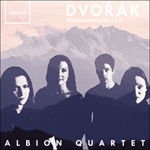
Welcome to Hyperion Records, an independent British classical label devoted to presenting high-quality recordings of music of all styles and from all periods from the twelfth century to the twenty-first.
Hyperion offers both CDs, and downloads in a number of formats. The site is also available in several languages.
Please use the dropdown buttons to set your preferred options, or use the checkbox to accept the defaults.

| Albion Quartet» More |
The first movement, Allegro ma non troppo, is typical of Dvořák in being a sonata form adapted to make it seem looser and less obviously sectional. Its basic mood, though, is elegiac—perhaps a homage to the Schubertian influences that had earlier sustained him. The second main theme hardly alters the mood and it is only in the development section that a more energetic, dance-like atmosphere briefly emerges. Although the recapitulation is disguised, the main theme reappears as a coda, restoring the serenity of the movement as a whole.
The second movement, Andante con moto, is the quartet’s first obvious gesture to the requested 'Slavonic' atmosphere: like the second movement of No 8 it is a dumka, although now in the more usual 2/4 metre. This dumka still has the required melancholy atmosphere, and hints of improvisation, but is much more thoroughly integrated into the string quartet texture (the main melody is shared between the first violin and Dvořák’s beloved viola) and displays evident resonances of the first movement’s main theme. The Andante then alternates with a Vivace section with obvious 'folk' gestures.
The third movement, also Andante con moto, is called 'Romanza' and, true to its title, explores some obvious operatic effects. The mysterious opening might be a gesture to an offstage choir; then some recitative-like moments usher in a serene melody that dominates the movement, unfolding like a theme and variations rather than anything more developmental. The ending sees a return to the offstage choir, mingled with the main theme to produce a serene close, again reminiscent of the first movement.
The last movement, Allegro assai, has another 'Slavonic' reference, this time to a lively Czech dance called the skočná, already something of a cliché through its use in the Act 3 circus scene of Smetana’s Bartered Bride. Simply stated at the start, this dance soon becomes absorbed in complex string quartet textures (again the viola is prominent), with quasi fugal developments and counter melodies galore; slower sections again gesture towards earlier movements, but in the end the skočná returns triumphant.
from notes by Roger Parker © 2020
 Dvořák: String Quartets Nos 8 & 10 Dvořák: String Quartets Nos 8 & 10Formed in 2016, the Albion Quartet unites four outstanding young string players brought together by a shared belief in the visceral power of the string quartet. Here they continue their cycle of Dvořák String Quartets with Nos 8 & 10.» More |

